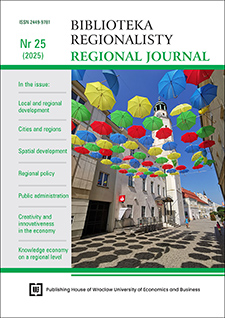Human capital as a key element supporting innovationin regions
DOI:
https://doi.org/10.15611/br.2025.1.17Keywords:
human capital, innovation, regionsAbstract
Aim: The aim of the article was to theoretically analyse the importance of human capital and innovation in the process of regional development within the framework of a knowledge-based economy.
Methodology: The article employs a literature review and a descriptive method to explore the relationship between human capital and the ability of regions to introduce innovations.
Results: Human capital – defined as the knowledge, skills, experience, and creativity of a region's inhabitants – plays a key role in innovation processes. Regions with well-developed human capital demonstrate greater potential for implementing innovations, which strengthens their competitiveness and fosters economic growth.
Implications and recommendations: Strengthening human capital should be a priority in regional policy. Investment in education, skills development, and fostering creativity enhances a region's ability to generate and apply innovations effectively.
Originality/value: The article provides added value by highlighting the fundamental role of human capital as a driver of innovation and regional competitiveness in the modern knowledge-based economy.
Downloads
References
Bartnik, K. M. (2016). Znaczenie kapitału ludzkiego i społecznego w rozwoju regionalnym na przykładzie Finlandii [The Importance of Human and Social Capital in Regional Development on the Example of Finland]. Studia Oeconomica Posnaniensia, 4(6), 13-17.
Centre for Educational Research and Innovation OECD. (1998). Human Capital Investment. An international Comparison. OECD.
Cooke, P. (1992). Regional Innovation Systems: Comparative Regulation in the New Europe. Geoforum, 35, 365-382.
Cooke, P., Heidenreih, M., & Braczyk, H-J. (Eds.). (2004). Regional Innovation Systems. The Role of Governances in a Globalized World. Routledge.
Domański, R. S. (1993). Kapitał ludzki i wzrost gospodarczy [Human Capital and Economic Growth]. PWN.
Etzkowitz, H. (2002). Incubation of Incubators: Innovation as a Triple Helix of University-Industry-Government Networks. Science and Public Policy, 29(2), 115-128.
Florida, R. (2000). The Learning Region. In Z. J. Acs (Ed.), Regional Innovation, Knowledge and Global Change (pp. 58-72). Routledge.
Florida, R. (2004). The Rise of the Creative Class: And How It’s Transforming Work, Leisure, Community and Everyday Life. Basic Books.
Friedmann, J. (1969). A General Theory of Polarized Development. University of California at Los Angeles, School of Architecture and Urban Planning.
Golejewska, A. (2012). Kapitał ludzki, innowacje i instytucje a konkurencyjność regionów [Human Capital, Innovations and Institutions and the Competitiveness of Regions]. Centrum Europejskie Natolin.
Grosse, T. G. (2007). Innovative Economy on the Periphery? Institute of Public Affairs.
Hryniewicki, M. (2006). Konkurencyjność regionów w warunkach integracji Polski z Unią Europejską [Competitiveness of Regions in the Context of Poland's Integration with the European Union]. In A. Sadowski, & M. Hryniewicki (Eds.),
Integracja europejska: pierwsze doświadczenia [European Integration. First Experiences] (pp. 27-28). University of Białystok Publishing House.
Kot, J. (2007). Konkurencyjność i innowacyjność w rozwoju regionalnym [Competitiveness and Innovation in Regional Development] In J. Kot (Ed.), Analiza strukturalna gospodarki Regionu Świętokrzyskiego i jej wykorzystanie pod kątem podnoszenia konkurencyjności i innowacyjności regionu [Structural Analysis of the Świętokrzyskie Region Economy and
Its Use in Terms of Increasing the Region’s Competitiveness and Innovation] (pp. 10-11). Świętokrzyska Academy.
Łaźniewska, E., & Gorynia, M. (Eds.) (2012). Konkurencyjność regionalna. Koncepcje – strategie – przykłady [Regional Competitiveness. Concepts – Strategies – Examples]. PWN Scientific Publishing House.
Makieła, Z. (2013). Przedsiębiorczość i innowacyjność terytorialna Region w warunkach konkurencji [Entrepreneurship and Territorial Innovation. Region in Competitive Conditions]. C.H. Beck.
Markowski, T. (2004). Kapitał ludzki a potencjał innowacyjny polskich regionów. Wydawnictwo Naukowe Scholar.
Nowakowska, A. (2013). Terytorium – źródło procesów innowacji [Territory – the Source of Innovation Processes]. In A. Nowakowska (Ed.), Zrozumieć terytorium. Idea i praktyka [Understanding Territory. Idea and Practice] (pp. 39-57). University of Lodz Publishing House.
Olechnicka, A. (2012). Potencjał nauki a innowacyjność regionów [The Potential of Science and the Innovativeness of Regions]. Wydawnictwo Naukowe Scholar.
Storper, M. (1995). Regional “Worlds” of Production: Learning and Innovation in the Technology Districts of France, Italy and the USA. Regional Studies, 27, 433-455.
Strahl, D. (2006). Innowacyjność regionów Polski na tle Europejskiej Przestrzeni Regionalnej ze względu na rozwój sektora usług [Innovativeness of Polish Regions in the Context of the European Regional Space Due to the Development of the Services Sector]. Prace Naukowe Akademii Ekonomicznej we Wrocławiu, (1124), s. 27-36.
Tuziak, A. (2013). Innowacyjność w endogenicznym rozwoju regionu peryferyjnego. Studium socjologiczne [Innovation in the Endogenous Development of a Peripheral Region. A Sociological Study]. Wydawnictwo Naukowe Scholar.
Wosiek, M. (2012). Regionalne zróżnicowanie kapitału intelektualnego [Regional Differentiation of Intellectual Capital]. In M. G. Woźniak (Ed.), Gospodarka Polski 1990-2011. T. 2. Modernizacja [Economy of Poland 1990-2011. Vol. 2. Modernization] (pp. 49-76). PWN Scientific Publishing House.
Downloads
Published
Issue
Section
License
Copyright (c) 2025 Tomasz Łuczyszyn

This work is licensed under a Creative Commons Attribution-ShareAlike 4.0 International License.
Accepted 2025-05-23
Published 2025-07-16







